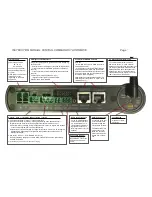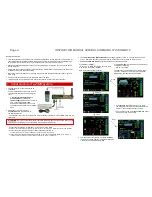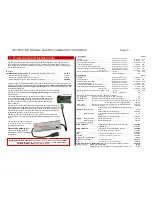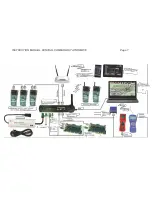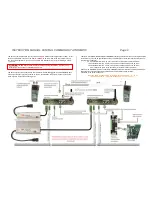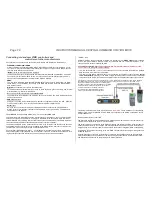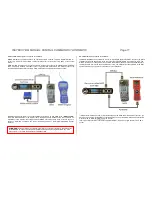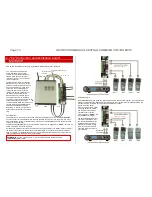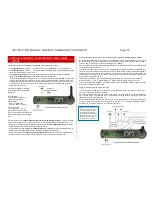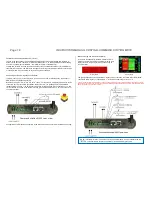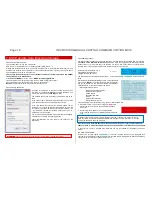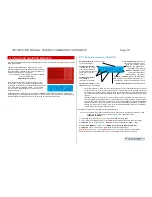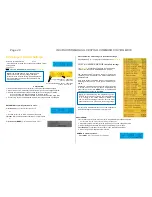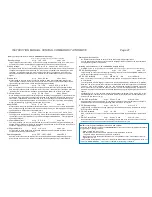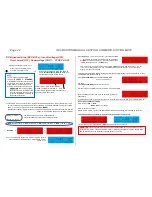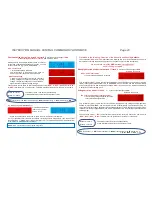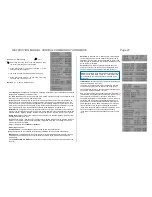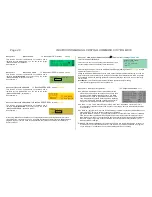
Page 14 INSTRUCTION MANUAL CENTRAL COMMAND STATION MX10
Connecting a Roco Lokmaus via a 6-pole cable to an XNET socket on the MX10AVP.
(of course you would not need a connection and expansion board for just one Lokmaus,
but in combination with one of the cases described above, this kind of connection is useful).
Further applications:
Additionally to, or instead of, the CAN bus applications described above, the connection and expan-
sion board MX10AVP is also used:
- as connection to XpressNet devices: Roco Lokmäuse or DiMAX Navigator radio receiver. The ZIMO
central command station MX10 supplies two Xpress networks, which are combined in one socket
(“XNET”); MX10AVP has separated sockets “XNET-1” ad “XNET-2” (between the CAN sockets).
- to control comfortably (via spring clips) the 16-pole pin connector on the MX10, i.e. 8 inputs (for con-
tact rails, emergency stop buttons, etc.) and 8 outputs.
Output
track 1:
Default
- Voltage ..........................................
(adjustable in 0.2 V steps) .....
10 to 24 V 16 V
- Start-up voltage .......................................
(adjustable in 1 A steps) ......
1 to 12 A 5 A
- Start-up time of the voltage ............................................
(adjustable in 1 sec steps) ......
1 to 60 sec 1 sec
-
Overcurrent threshold ……………………...………………
(adjustable in 0.1 A steps) ......
1 to 12 A 5 A
- Turn-off time in case of an overcurrent .....................
(adjustable in 0.1 sec steps) ......
0.1 to 5 sec 0.2 s.
- Tolerated overcurrent threshold surpassing of ....
(adjustable in 0.5 A steps) ......
0 to 4 A 0 A
for a time of .................
(adjustable in 0.5 sec steps) ......
1 to 60 sec 0 sec
- Spark suppression
(selection between Off/Lev1/Lev2
)........ Level 1 ......................
………. 8 A OFF
Level 2 (sensitive) ......................
………. 4 A
Output
track 2:
Default
- Voltage ............................................
(adjustable in 0.2 V steps) .....
10 to 24 V 16 V
- Start-up voltage .......................................
(adjustable in 1 A steps) ......
1 to 8 A 3 A
- Start-up time of the voltage ............................................
(adjustable in 1 sec steps) ......
1 to 60 sec 1 sec
-
Overcurrent threshold ……………………...………………
(adjustable in 0.1 A steps) ......
1 to 8 A 3 A
- Turn-off time in case of an overcurrent .....................
(adjustable in 0.1 sec steps) ......
0.1 to 5 sec 0.2 s.
- Tolerated overcurrent threshold surpassing of ....
(adjustable in 0.5 A steps) ......
0 to 4 A 0 A
for a time of .................
(adjustable in 0.5 sec steps) ......
1 to 60 sec 0 sec
- Spark suppression
(selection between Off/Lev1/Lev2
)........ Level 1 ......................
……… 8 A OFF
Level 2 (sensitive) ......................
……… 4 A
DC outputs S1 and S2 (in the circuits for “track1” and “track 2”)
DC output 30 V
(Supply for devices connected via CAN bus cable) ...
4 A
DC output 12 V
(Supply for devices connected to XNET and LocoNet)...
1.5 A
LED outputs
(6 pins on 2x8-pole pin connectors)
- constant current at 15 mA .....
max. 25 mA
“out 5” and “out 6” are suitable for relay ...
100 mA
AOS inputs
(8 pins on 2x8-pole pin connector)
to ground or switching threshold 0 to 32 V
Audio output
(Jack socket 2.5 mm) ............................................
Line-out
RailCom
Detector track
1
measurable minimum amplitude of the RailCom
signals...
4 mA
Sample rate (3-fold oversampling) ......................
750 kHz
Detector track 2
measurable minimum amplitude of the RailCom
signals...
4 mA
Sample rate (3 fold oversampling) ......................
750 kHz
ZACK
Detector track
1
Detection threshold ...............................
500 mA
Detector track 2
Detection threshold ...............................
500 mA
Communication via cable:
ZIMO CAN bus 1 .....................
(ZIMO CAN sockets in the front and the back) ....
125 kBd
..............................
prepared for ............................
512 kBd
ZIMO CAN bus 2 .....................
(with special 8 pole cable: XNET socket) .......
125 kBd
........................
depending on the protocol up to .....
512 kBd
XNET ...................................................................................
62.5 kBd
XN2 ........................................
(2nd XNET or open DCC bus)
not yet in use
..
512 kBd
LocoNet .............................
at this moment the software is not prepared
.............................
16.6 kBd
USB device (client) interface.... ..............................................
1 Mbit/s
USB 2.0 host interface………
(for USB and future use)
.............
12 Mbit/s
LAN ………………………………..
(Ethernet, also to connect a WiFi router)
......
10 Mbit/s
Communication via radio:
Mi-Wi network
(derivative of the ZigBee standard, 2.4 GHz) .......
about
20
kbit/s
Internal memory:
DRAM and SRAM (random access memory)
64 MB
NAND flash (pictures, databases, interlocking systems, sound files, etc.) 4 GB



